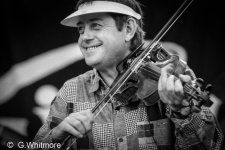and please use their services
You are using an out of date browser. It may not display this or other websites correctly.
You should upgrade or use an alternative browser.
You should upgrade or use an alternative browser.
Photoshop's new (to me) colorize feature.
- Thread starter Graham W
- Start date
LongLensPhotography
Th..th..that's all folks!
- Messages
- 17,633
- Name
- LongLensPhotography
- Edit My Images
- No
It is presumably picking safe colours. Skin / lips should be fairly obvious for a well trained ML. Shirt is safe brown. Perhaps it could have picked blue for shirt, but it depends if it had been trained on this particular shirt in these colours before. Left hand is all wrong by the way. It is kind of greenish but you can fix it with brush set to colour mode.
- Messages
- 2,782
- Name
- Graham
- Edit My Images
- Yes
It is.Is that the one, under neural filters ?
Yes, I noticed that. and as you say, easy enough to fix.It is presumably picking safe colours. Skin / lips should be fairly obvious for a well trained ML. Shirt is safe brown. Perhaps it could have picked blue for shirt, but it depends if it had been trained on this particular shirt in these colours before. Left hand is all wrong by the way. It is kind of greenish but you can fix it with brush set to colour mode.
Here's another example from a scanned b&w negative.
(The wicket keeper is Richard Thompson...if you know, you know.

- Messages
- 6,636
- Name
- Tel
- Edit My Images
- No
Fairport Convention ?
- Messages
- 9,592
- Edit My Images
- Yes
- Messages
- 300
- Name
- Ham
- Edit My Images
- Yes
I've been playing with the colourise and other filters, and they are fun, unfortunately they show up the shortcomings on my creaky old system 
One thing I have discovered is that it pays to spend some time getting brightness and contrast better before applying the filter. In the context of the filter, "better" often means more marked rather than better to the eye, as ever the histogram is your friend. Probably more significant on scanned b&w snapshots rather than negs. The AI works best when it "knows" some of the colour, for example a sandy beach, but it isn't beyond making some of it green, coz after all ground is grass is green. A good tutorial is to find a photo you know the colours in, eg a school uniform, and play with the curve until it interprets it as the right colour. The tweaking controls can be used to improve the final result, but they can't change, for example, red to blue.
Another use for the colourising tool is re-working faded colour snapshots, when it really smashes it out the park.
I haven't been playing with the more esoteric filters yet, but another useful tweak to know about is the half tone screen filter (in photo repair tweak controls) that does an interesting job on newspaper photos, use with care if you don't want a boy's own comic look.
One thing I have discovered is that it pays to spend some time getting brightness and contrast better before applying the filter. In the context of the filter, "better" often means more marked rather than better to the eye, as ever the histogram is your friend. Probably more significant on scanned b&w snapshots rather than negs. The AI works best when it "knows" some of the colour, for example a sandy beach, but it isn't beyond making some of it green, coz after all ground is grass is green. A good tutorial is to find a photo you know the colours in, eg a school uniform, and play with the curve until it interprets it as the right colour. The tweaking controls can be used to improve the final result, but they can't change, for example, red to blue.
Another use for the colourising tool is re-working faded colour snapshots, when it really smashes it out the park.
I haven't been playing with the more esoteric filters yet, but another useful tweak to know about is the half tone screen filter (in photo repair tweak controls) that does an interesting job on newspaper photos, use with care if you don't want a boy's own comic look.
- Messages
- 2,782
- Name
- Graham
- Edit My Images
- Yes
Re-working faded colour shots is a good thought.. Thanks.I've been playing with the colourise and other filters, and they are fun, unfortunately they show up the shortcomings on my creaky old system
One thing I have discovered is that it pays to spend some time getting brightness and contrast better before applying the filter. In the context of the filter, "better" often means more marked rather than better to the eye, as ever the histogram is your friend. Probably more significant on scanned b&w snapshots rather than negs. The AI works best when it "knows" some of the colour, for example a sandy beach, but it isn't beyond making some of it green, coz after all ground is grass is green. A good tutorial is to find a photo you know the colours in, eg a school uniform, and play with the curve until it interprets it as the right colour. The tweaking controls can be used to improve the final result, but they can't change, for example, red to blue.
Another use for the colourising tool is re-working faded colour snapshots, when it really smashes it out the park.
I haven't been playing with the more esoteric filters yet, but another useful tweak to know about is the half tone screen filter (in photo repair tweak controls) that does an interesting job on newspaper photos, use with care if you don't want a boy's own comic look.
- Messages
- 3,172
- Name
- North York Moors
- Edit My Images
- Yes
I have found this online tool is as good if not better than the photoshop neural filter, it sometimes gets quite slow though.
 imagecolorizer.com
Worth a play. It usually picks up skin tones, grass and trees and sky pretty well.
imagecolorizer.com
Worth a play. It usually picks up skin tones, grass and trees and sky pretty well.
Colorize | Colorize Black and White Photos and Pictures
Transform your old, historical, and black & white photos into vivid, lifelike images with Colorize. Our online tool makes it easy to add color to your cherished memories. Try Colorize today and bring your photos to life!




